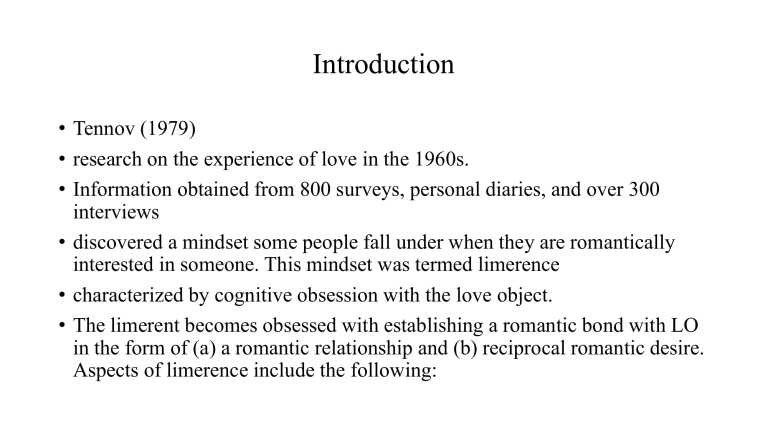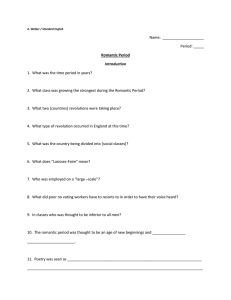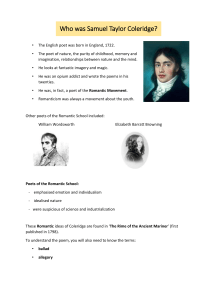
Introduction • Tennov (1979) • research on the experience of love in the 1960s. • Information obtained from 800 surveys, personal diaries, and over 300 interviews • discovered a mindset some people fall under when they are romantically interested in someone. This mindset was termed limerence • characterized by cognitive obsession with the love object. • The limerent becomes obsessed with establishing a romantic bond with LO in the form of (a) a romantic relationship and (b) reciprocal romantic desire. Aspects of limerence include the following: Related Aspects • Limerence can begin with a trivial gesture from LO, such as a smile, that is interpreted as hidden affection. • An intense yearning to establish a romantic bond with LO that supersedes other concerns. • Intrusive cognitive preoccupation with LO that includes anticipating future interactions with LO, replaying past interactions with LO, either for pleasure or in search for signs of LO’s romantic desire, and fantasies of LO reciprocating romantic desire. • Self-consciousness in the presence of LO that can range from general shyness to extreme apprehension, and an inordinate fear of being rejected as a relationship partner by LO. • Acute sensitivity to LO’s behaviors, including interpreting LO’s behaviors as diagnostic of LO’s level of romantic desire. • Mood swings that are contingent on perceived likelihood that LO reciprocates or will reciprocate romantic desire. • Awareness of being in an altered state of mind, and an inability to exit the limerent state or become limerent towards another LO. • Downplaying of LO’s negative attributes In Relation with Organizations and Work Place • Wine and Dine a Common Strategy • Flattery and Manipulation • individuals with Sensitive and classified Information may be targeted * Supporting ROL required. Application • Can help in recruitment process for certain roles and in certain industries that involve a lot of interpersonal interactions • Assigning Job Roles and Projects Review of Literature • Wolf (2017) Created and assessed the reliability and validity of a new measure of Limerence Low self-esteem, attachment anxiety, low self-concept clarity, need to belong, validation-seeking goal orientation, social phobia, social interaction anxiety, and mind-wandering were found to be associated with limerence The association between low self-esteem and limerence was found to be mediated mostly through social phobia and validation-seeking goal orientation • Feeney & Noller, 1990 a study linking limerence to anxious attachment Relationship exists (lack of full access) Flett, Hewitt, Shapiro, & Rayman (2001)• limerence with perfectionism indicated that individuals with high levels of self-oriented perfectionism and other-oriented perfectionism have stronger relationship beliefs in the areas of communication, trust, and support suggests that perfectionists have high relationship standards in these particular areas. • Banker (2010) hypothesized that an association exists between socially prescribed perfectionism and limerence, specifically in intimate relationships. A theoretical comparison supported the hypothesis, concluding that common characteristics of both concepts include obsessive and intrusive preoccupations, low self-esteem, fear of negative evaluation, failure and rejection, emotional dependence on others, poor selfcontrol, self-conscious anxiety, hopelessness, depression and suicidality Both concepts were also correlated with neurotic tendencies, an external locus of control and anxious/ambivalent attachments • Subscale under Love Attitudes Scale by Hendrick, C. & Hendrick, S. (1986) • Subscale under Romantic Love Scale Rubin, Z (1970) • No scale or relevant research seems to exist in organizational context References • Banker, R. M. (n.d.). Socially prescribed perfectionism and limerence in interpersonal relationships. Retrieved from https://scholars.unh.edu/thesis/126/ • Feeney, J. A., & Noller, P. (1990). Attachment style as a predictor of adult romantic relationships. Journal of Personality and Social Psychology,58(2), 281-291. doi:10.1037//0022-3514.58.2.281 • Flett, G. L., Hewitt, P. L., Shapiro, B., & Rayman, J. (n.d.). Perfectionism, beliefs, and adjustment in dating relationships. Retrieved from https://link.springer.com/article/10.1007/s12144-001-10134 • Hendrick, C., & Hendrick, S. (1986). A theory and method of love. Journal of Personality and Social Psychology,50(2), 392-402. doi:10.1037//0022-3514.50.2.392 • Rubin, Z. (1970). Measurement of romantic love. Journal of Personality and Social Psychology,16(2), 265-273. doi:10.1037/h0029841 • Wolf, R. N. (2017, January). Investigating Limerence: Predictors of Limerence, Measure Validation, and Goal Progress. Retrieved from https://drum.lib.umd.edu/handle/1903/20272



